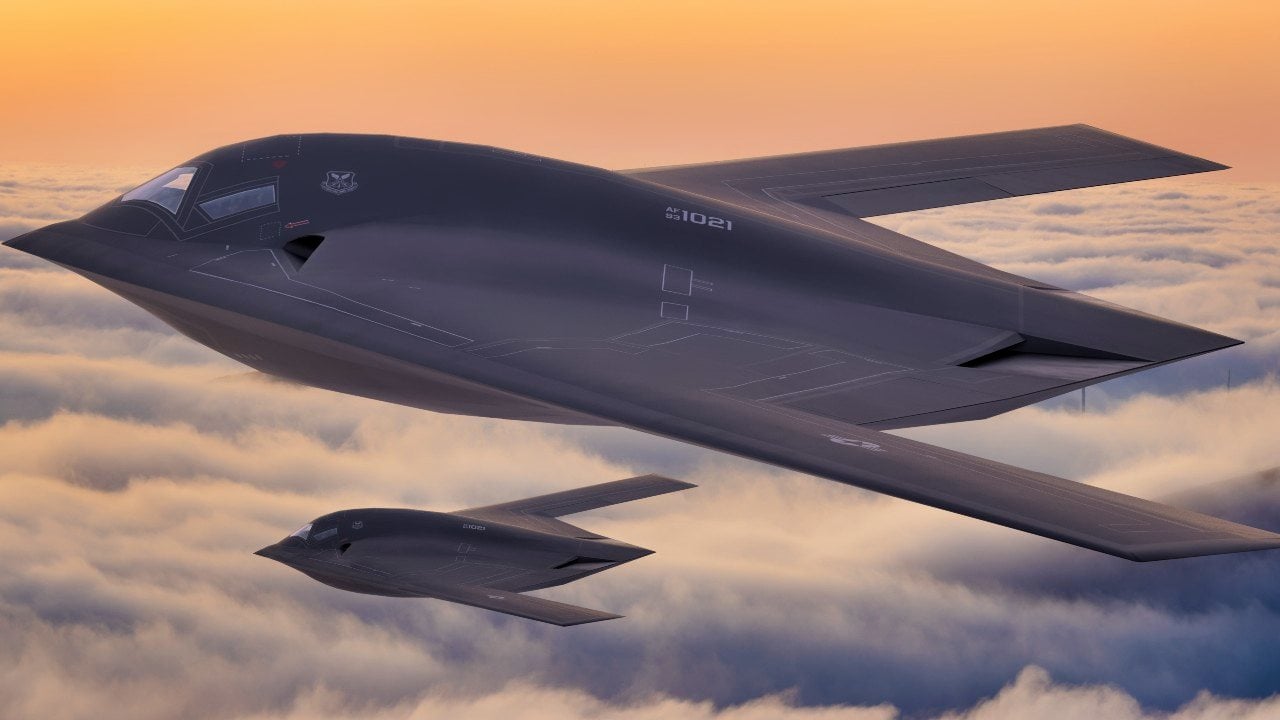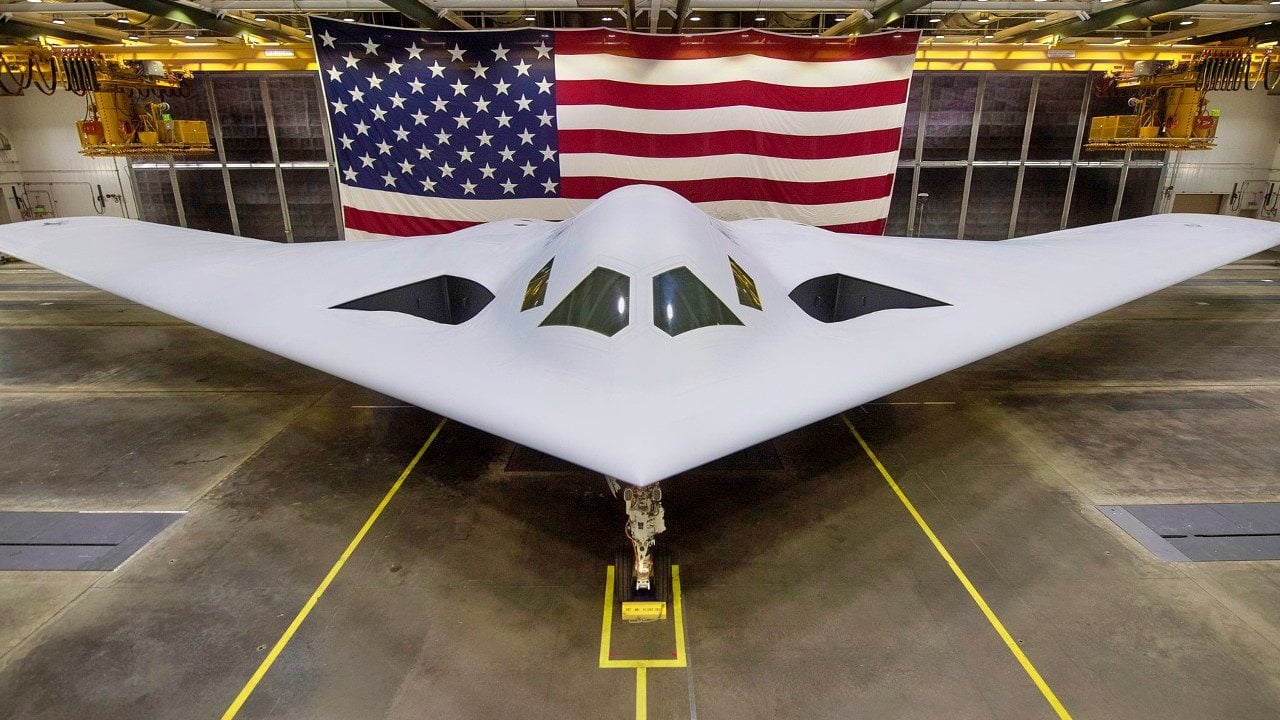B-21 Raider: Could This be the Last Bomber the Air Force Flies? – Last year the U.S. Air Force (USAF) and defense contractor Northrop Grumman unveiled the B-21 Raider, the newest addition to the USAF’s bomber fleet.
In November, the distinctive flying wing form of the bomber was seen taking to the skies for the first time from the USAF’s Plant 42 in Palmdale, CA.
This flight represents a significant development for the USAF’s strategic bomber forces, who have not had a new aircraft since the B-2 Spirit began flying over 30 years ago.
While the B-21 represents the current pinnacle of aircraft technology and design, it may also be the swan song of manned bombers.
FAQ and Answers – Meet the B-21 Raider
From the outside, the B-21 Raider closely resembles its predecessor, the B-2 Spirit. But many ask, how is the B-21 Raider different?
Both are stealth bombers with a unique “flying wing” shape. This configuration reduces the amount of surfaces on the aircraft giving it a much smaller radar cross section (RCS) for stealth capabilities and reducing drag to increase range.
Notably, the B-21 is also smaller than the B-2, making it even more challenging to detect.
Beyond its externals, not much is known about the Raider’s specifications.
In keeping with the mission of strategic bombing, it will be able to carry out long-range strike missions from bases in the U.S. and will be nuclear-capable.
The most striking aspect is reports from the USAF that it will be capable of unmanned missions.
Unmanned Future for the Raider?
Advancements in AI have brought the idea of fully unmanned aircraft to the forefront of aviation design.
Air services around the globe are pursuing multiple avenues of remote or AI controlled aircraft, from the U.S. Navy’s MQ-25 stingray to the Collaborative Combat Aircraft (CCA) of the Next Generation Air Dominance (NGAD) program.
It’s unclear exactly where on this spectrum the B-21 would fall. It is designed as a manned platform.
However, AI assistance could reduce crewing requirements – the USAF is already working with Lockheed Martin on a program to allow AI to stand in as a copilot on the C-130, requiring only one human pilot. This scenario could ease the pilot shortage the USAF is experiencing. Current projections place the service at almost 2,000 pilots short of planned operational requirements.
The Next-Generation Air Dominance (NGAD) program’s Collaborative Combat Aircraft (CCAs) are envisioned as “uncrewed — and possibly attritable or even expendable — combat aircraft that can team up with manned aircraft and open up a new range of tactics.”
Regarding the B-21, it is unclear whether the B-21 would constitute the CCA or, like the F-35, a crewed variant would serve as “quarterback” for multiple uncrewed wingmen.
Other autonomous designs currently in the works are the Air Combat Evolution program from DARPA, the Air Force Research Laboratory’s Skyborg program and Boeing Australia’s MQ-28A Ghost Bat project. These research endeavors hope to employ a pilot/AI interface to improve dogfighting capabilities and their results will doubtless be applied to unmanned programs across the spectrum of development.
Regardless of what the autonomous aviation of the future ends up being, the B-21 is poised to take advantage. It is designed with open-source architecture much like the F-35 meaning changes and upgrades will require much less work to implement.

In addition to its potential for development, the Raider will have an immediate impact on air warfare. In part, it helps the U.S. stay on pace with its near-peer rivals and pacing partners – China and Russia, both of whom are working on stealth bombers of their own: the H-20 and the PAK DA.
The Chinese have never developed a stealth bomber domestically, so they will doubtless face challenges, and the Russians are facing issues due to the war in Ukraine. The U.S. must maintain its dominance in the stealth bomber arena. The U.S. is also no longer the only operator of fifth-generation aircraft. Both Beijing and Moscow have developed their advanced jet programs- the Chengdu J20 and Sukhoi Su-57, respectively.

Furthermore, the B-21 demonstrates the U.S. commitment to deterrence. As Defense Secretary Lloyd Austin said during the unveiling of the Raider: “America’s defense will always be rooted in deterring conflict. So we are again making it plain to any potential foe that the risk and the cost of aggression far outweigh any conceivable gains.”
Given the three-decade gap between the B-2 and the B-21, indicative of the long lead times required for developing new aircraft and the rapid advancements in AI technology, the B-21 Raider may be the last manned bomber to fulfill this mission.
About the Author
Maya Carlin is an analyst with the Center for Security Policy and a former Anna Sobol Levy Fellow at IDC Herzliya in Israel. She has by-lines in many publications, including The National Interest, Jerusalem Post, and Times of Israel. You can follow her on Twitter: @MayaCarlin.